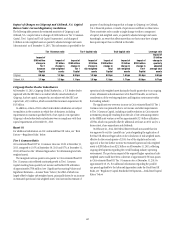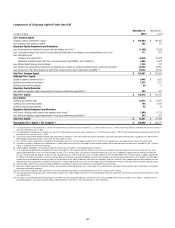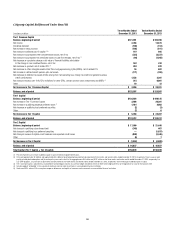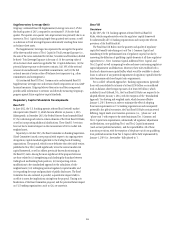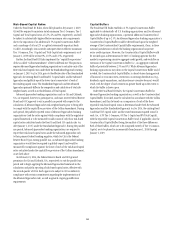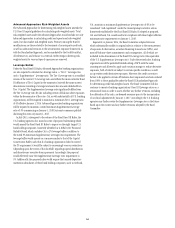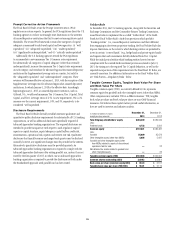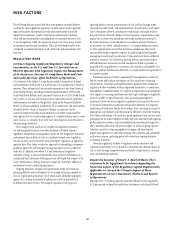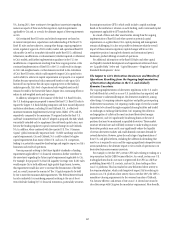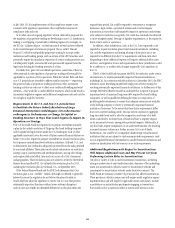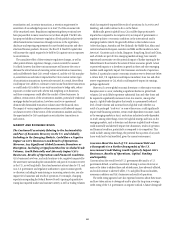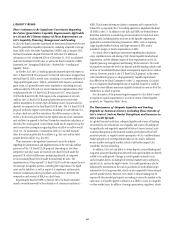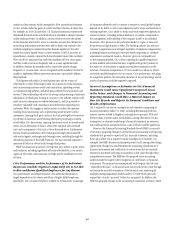Citibank 2013 Annual Report Download - page 75
Download and view the complete annual report
Please find page 75 of the 2013 Citibank annual report below. You can navigate through the pages in the report by either clicking on the pages listed below, or by using the keyword search tool below to find specific information within the annual report.57
N.A., during 2013, there continues to be significant uncertainty regarding
numerous aspects of these and other regulatory capital requirements
applicable to Citi and, as a result, the ultimate impact of these requirements
on Citi.
Citi’s estimated Basel III ratios and related components are based on
its current interpretation, expectations and understanding of the final U.S.
Basel III rules and are subject to, among other things, ongoing regulatory
review, regulatory approval of Citi’s credit, market and operational Basel III
risk models (as well as its market risk models under Basel II.5), additional
refinements, modifications or enhancements (whether required or otherwise)
to Citi’s models, and further implementation guidance in the U.S. Any
modifications or requirements resulting from these ongoing reviews or the
continued implementation of Basel III in the U.S. could result in changes
in Citi’s risk-weighted assets or other elements involved in the calculation
of Citi’s Basel III ratios, which could negatively impact Citi’s capital ratios
and its ability to achieve its capital requirements as it projects or as required.
Further, because operational risk is measured based not only upon Citi’s
historical loss experience but also upon ongoing events in the banking
industry generally, Citi’s level of operational risk-weighted assets could
remain elevated for the foreseeable future, despite Citi’s continuing efforts to
reduce its risk-weighted assets and exposures.
In addition, subsequent to the issuance of the final U.S. Basel III rules,
the U.S. banking agencies proposed to amend the final U.S. Basel III rules to
require the largest U.S. bank holding companies and their insured depository
institution subsidiaries, including Citi and Citibank, N.A., to effectively
maintain minimum Supplementary Leverage ratios (SLRs) of 5% and 6%,
respectively, compared to the minimum 3% required under the final U.S.
and Basel Committee Basel III rules. If adopted as proposed, the SLR, which
was initially intended only to supplement the risk-based capital ratios, may
become the binding regulatory capital constraint facing Citi and Citibank,
N.A. In addition, when combined with the expected U.S. Tier 1 Common
Capital “global systemically important bank” (G-SIB) surcharge and other
capital requirements, Citi and Citibank, N.A. could be subject to higher
capital requirements than many of their U.S. and non-U.S. competitors,
leading to a potential competitive disadvantage and negative impact on Citi’s
businesses and results of operations.
Various proposals relating to the future liquidity standards or funding
requirements applicable to U.S. financial institutions further contribute to
the uncertainty regarding the future capital requirements applicable to Citi.
For example, the proposed U.S. Basel III Liquidity Coverage ratio (LCR) rules
would require Citi to hold additional high-quality liquid assets; however,
this requirement would also serve to increase the denominator of the SLR
and, as a result, increase the amount of Tier 1 Capital required to be held
by Citi to meet the minimum SLR requirements. The Federal Reserve Board
has also indicated it is considering proposals relating to the use of short-
term wholesale funding by U.S. financial institutions, particularly securities
financing transactions (SFTs), which could include a capital surcharge
based on the institution’s reliance on such funding, and/or increased capital
requirements applicable to SFT matched books.
As a result of these and other uncertainties arising from the ongoing
implementation of Basel III and other current or potential capital
requirements on a global basis, Citi’s capital planning and management
remains challenging. It is also not possible to determine what the overall
impact of these extensive regulatory capital changes will be on Citi’s
competitive position (among both domestic and international peers),
businesses, product offerings or results of operations.
For additional information on the Basel III Rules and other capital
and liquidity standards developments and requirements referenced above,
see “Liquidity Risks” below and “Capital Resources—Regulatory Capital
Standards Developments” above.
The Impact to Citi’s Derivatives Businesses and Results of
Operations Resulting from the Ongoing Implementation
of Derivatives Regulation in the U.S. and Globally
Remains Uncertain.
The ongoing implementation of derivatives regulations in the U.S. under
the Dodd-Frank Act as well as in non-U.S. jurisdictions has impacted, and
will continue to substantially impact, the derivatives markets by, among
other things: (i) requiring extensive regulatory and public price reporting
of derivatives transactions; (ii) requiring a wide range of over-the-counter
derivatives to be cleared through recognized clearing facilities and traded
on exchanges or exchange-like facilities; (iii) requiring the collection
and segregation of collateral for most uncleared derivatives (margin
requirements); and (iv) significantly broadening limits on the size of
positions that may be maintained in specified derivatives. These market
structure reforms have and will likely continue to make trading in many
derivatives products more costly, may significantly reduce the liquidity
of certain derivatives markets and could diminish customer demand for
covered derivatives. However, given the early stage of implementation of
these U.S. and global reforms, including the additional rulemaking that
may be or is required to occur and the ongoing significant interpretive issues
across jurisdictions, the ultimate impact to Citi’s results of operations in its
derivatives businesses remains uncertain.
For example, in October 2013, certain CFTC rules relating to trading on a
swap execution facility (SEF) became effective. As a result, certain non-U.S.
trading platforms that do not want to register with the CFTC as a SEF are
prohibiting firms with U.S. contacts, such as Citi, from trading on their
non-U.S. platforms. This has resulted in some bifurcated client activity in
the swaps marketplace, which could negatively impact Citi by reducing its
access to non-U.S. platform client activity. Also in October 2013, the CFTC’s
mandatory clearing requirements for the overseas branches of Citibank,
N.A. became effective, and certain of Citi’s non-U.S. clients have ceased to
clear their swaps with Citi given the mandatory requirement. More broadly,


